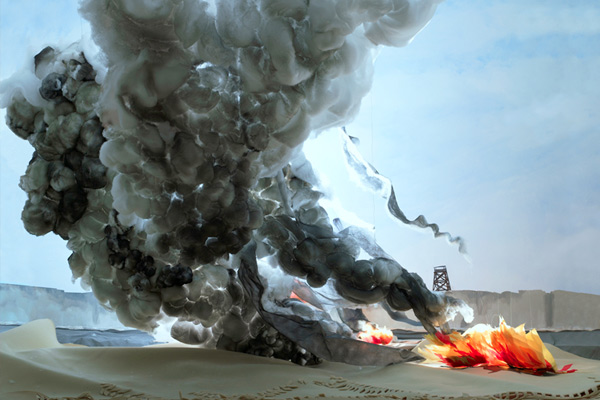
CCA’s Dust in the Machine Asks If Then Is Now, But Quietly
Dust in the Machine opened on September 21st at the CCA, in conjunction with ISEA2012 Albuquerque: Machine Wildnerness. The show presents eight artists whose work takes the landscape as evidence of civilization and engages in dialogue with the pros and cons of the 20th-century’s effect on that landscape during this age of the ‘machine.’ The 20th-century in the United States was a period of industrialization initiated by expansion into the West. The intensely bustling time abounded in new mechanics. Dust in the Machine, though, has a surprising lack of mechanization in aggregate, and is a quiet contemplative show considering the inheritance of 20th-century automation. Perhaps this is the point.
If considered as a time capsule of American industrialization, curator Erin Elder’s first efforts in the Munoz-Waxman Gallery seem deliberate and spare. Select sculptural objects with plenty of space around them make the large gallery feel expansive.
Jesse Vogler’s Internal Improvement IV leans against the wall suggestive of one of John McCracken’s planks, though the juxtapositions of symbology suggest that the American West was undergoing some internal improvements the way an office might — and the time frame is ambiguous. Two wooden support structures frame a piece of worn-out asphalt with yellow street lines. Three carpet swatches on top. The move from exterior to interior is perplexing. All the materials appear worn but wear by abrasions from different things—feet versus cars. The landscape here is the street and the rug is interjected, living in a non-domestic environment. Both wear by the traffic of people, but one through the mediation of a machine and the other directly. Their overlapping raises the question of whether unity is the case, or commentary on making passages pedestrian rather than mechanistic; is that an improvement?

 Vogler’s set of clear white polyurethane construction cones sits nearby but isolated. Again they seem to exist in a void of gallery space making the time they belong to appear uncertain. Their translucent skin is ghost-like in comparison to the bright orange cones we see on roadways, plastic fabricated to alert motorists to danger, not pull them into an undefined dreamscape.
Vogler’s set of clear white polyurethane construction cones sits nearby but isolated. Again they seem to exist in a void of gallery space making the time they belong to appear uncertain. Their translucent skin is ghost-like in comparison to the bright orange cones we see on roadways, plastic fabricated to alert motorists to danger, not pull them into an undefined dreamscape.
Towering over the room is Bethany Delahunt’s Watchtower, one of three media pieces in the show. It stands tall, a wooden structure neatly composed and strongly built. The planks are delicately weathered and one is missing. You can climb it at your own risk and spy from a perched surveillance camera that peers down. The camera is muted gray with stacked double lenses. The landscape here is the gallery itself, made into a site of action, with implications of the individual in that landscape. Three large cumbersome video monitors at the gallery entry display the surveillance feed from this camera, your body and movements included.

Lucy Raven’s video China Town traces the life of copper from natural source to refined product. It chronicles quiet towns in Nevada with little activity, with farmers axing wood. The video is stop-motion, begging the question of why? out of all the 20th-century’s technology. China Town’s jerky flow of images conjures up footage from the Lumière Brothers’ Arrival of a Train, a time when film was a novelty. Stop-motion makes the medium known and this may be a good thing to remember. There’s a lot of labor that goes into refining copper, and it is taken for granted—just like technology. The third media work is Lisa K. Blatt’s two immense side-by-side video screens, one in black and white and the other in color. The white plumes appear first as clouds in the sky, peacefully wafting through the blue like they do here in the West. However, their beauty is disarming. The smoke rises from power plants, a reminder that technological freedom may be as natural to us now as a summer day but it is duplicitous.
Themes of surveillance continue with as many aerial images of topography as at a city planning meeting. Jamey Stillings’ photos visit the rebuilding of the Hoover Dam and Shirley Wegner creates imaginative maquettes of ruined landscapes. From afar they pass as warfare photojournalism but up close, their fictive landscapes are exposed. The flames are obviously textiles and the scale is off. Most obvious are the white thread lines that drop vertically through the image to hold up the faux flames. Explosion best reveals the thin filmy sheets of fiber clustered into smoky grey and orange swirls that emulate fire. Explosion with Tractor Traces depicts a desert and seeming oil eruption. The tractor traces resemble a slivered piecrust, smoothly rolled out with knife incisions. An authentic landscape is absent from Wegner’s photos, which offer instead ones invented and composed. Sure, we rarely see land unmediated but these images suggest that we don’t see land at all—only fabricated images.
Wind is the medium which usually blows dust. CCA’s title suggests that we have a new landscape — the machine. It blows dust, too, and perhaps that dust obscures the differences between natural and unnatural.
